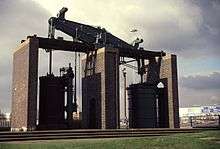A38(M) motorway
The A38(M), commonly known as the Aston Expressway, is a motorway in Birmingham, England. It is 2 miles (3.2 km) long and was opened on 24 May 1972.[1] It forms part of the much longer A38 route, connecting the M6 motorway to Aston and Central Birmingham.
| |
|---|---|
| Aston Expressway | |
| Route information | |
| Maintained by Birmingham City Council | |
| Length | 2.0 mi (3.2 km) |
| Existed | 1972–present |
| History | Opened and completed: 1972 |
| Major junctions | |
| North end | Gravelly Hill |
M6 motorway | |
| South end | Birmingham city centre |
| Location | |
| Counties | West Midlands |
| Primary destinations | Birmingham city centre |
| Road network | |
It is extremely unusual among UK motorways, as part of it consists of seven lanes with no central reservation, and operates a tidal flow system in an attempt to minimise congestion. Due to the nature of the road, the speed limit is reduced to 50 mph (80 km/h) for most of its length with a very short length of 30 mph (48 km/h),[2] though there are no permanent speed cameras.
When construction work of the motorway began in the late 1960s, many late 19th-century and early 20th-century houses in the Aston area had to be demolished to make way for the new route.
Route
_Aston_Expressway.jpg)
A38(M) runs from the A5127 through Gravelly Hill Interchange where the A38 joins and then shortly after traffic from the M6 motorway also joins. It then enters a tidal flow section. The road is on a viaduct as it passes through Aston; this section cuts through the grounds of Aston Hall.[3] The road passes through its first junction after 1 mile (1.6 km). It enters a cutting before reaching the second junction, where the tidal flow ends as does the motorway. The motorway is curved in Aston to avoid an Ansells brewery. The motorway was also crossed by a vinegar pipeline, carrying the condiment from one part of the since-demolished HP Sauce factory to the other.
Tidal flow
The Expressway was the first road in the United Kingdom to introduce tidal flow to allow better management of traffic. Lane use is controlled by means of electronic overhead signs, with one lane always closed to create a buffer between the two directions of travel – there is no central reservation. In the morning, four of the seven lanes are designated for use by traffic heading toward Birmingham city centre, and two lanes for traffic out of the city. In the evening rush hour, this pattern is reversed and four lanes are made available to outbound traffic and two lanes towards the city centre. At all other times, the road runs with three lanes in each direction.
Motorcycles are banned from the red-surfaced central lane, which contains a drainage channel, regardless of how it is being used. This follows a fatal accident which occurred when one of the drainage covers dislodged.[4]
Junctions
| A38(M) motorway | ||
| Northbound exits | Junction | Southbound exits |
| Road continues to Erdington as A5127 | M6 J6 Gravelly Hill |
Start of motorway |
| Lichfield A38 | No exit | |
| The SOUTH, Coventry The NORTH WEST, Wolverhampton M6 Aston A5127 |
No exit | |
| No exit | Park Circus (52.5021°N 1.8839°W) |
Aston B4132 |
| Start of motorway | Dartmouth Circus (52.4923°N 1.8887°W) |
Handsworth, Ladywood, Aston, Small Heath A4540 (Birmingham Inner Ring Road) |
| Handsworth, Ladywood, Aston, Small Heath A4540 (Birmingham Inner Ring Road) |
Road continues as A38 to Birmingham City Centre | |

The traffic island at Dartmouth Circus houses a preserved Boulton and Watt steam engine.
See also
| Wikimedia Commons has media related to A38(M) motorway. |
References
- The Motorway Archive A38(M) – Dates Archived 11 March 2007 at the Wayback Machine
- https://www.google.co.uk/maps/@52.4906935,-1.8889903,3a,75y,203.24h,84.6t/data=!3m6!1e1!3m4!1sRFkT6PbCktrodePaioHNmA!2e0!7i13312!8i6656
- The Motorway Archive – A38(M) Archived 11 March 2007 at the Wayback Machine
- CBRD Motorway Database – A38(M)
.svg.png)
.svg.png)